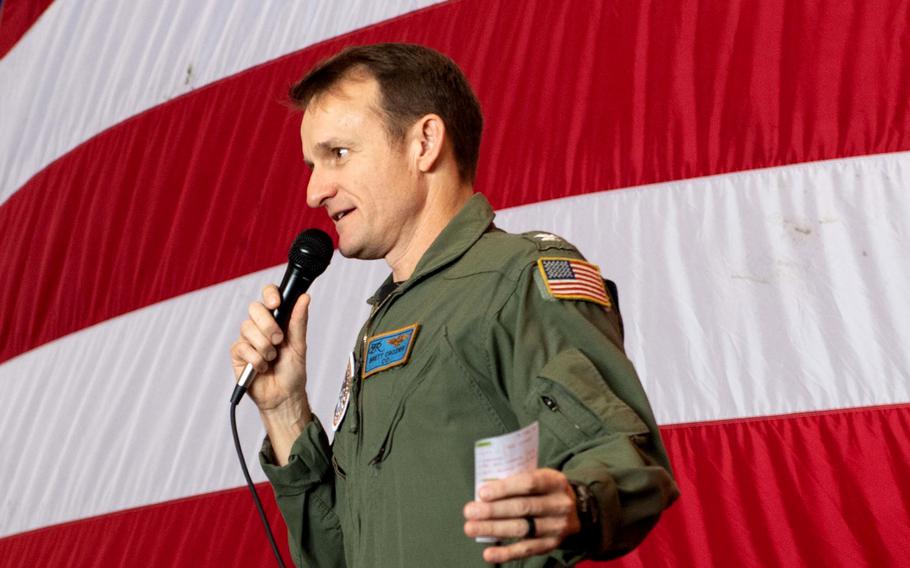
Capt. Brett Crozier, then-commanding officer of the aircraft carrier USS Theodore Roosevelt addresses the crew during an all-hands call in the ship’s hangar bay March 3, 2020. Crozier was relieved of command after his letter that warned sailors could die from the coronavirus outbreak aboard the carrier was leaked to the media. (Kaylianna Genier/U.S. Navy)
This story has been updated.
A cheering and applauding crowd of sailors aboard the aircraft carrier USS Theodore Roosevelt wished farewell to their captain, whom the Navy relieved of command after he raised concerns about the spreading coronavirus on his ship in a letter that was leaked to the media.
Hundreds were pictured in the gathering in the ship’s hangar deck and many chanted Capt. Brett Crozier’s name in multiple videos posted to social media.
A video posted Friday to the Facebook page of Michael Washington included the hashtags #MYCO and #WEARETRSTRONG.
“That’s how you send out one of the greatest captains you ever had,” someone says in the video, then using an acronym for greatest of all time, adds: “The GOAT, the man for the people.”
Crozier was dismissed Thursday due to a loss of confidence in his ability to command and for not using his chain of command to make service leaders aware of his concerns about the virus outbreak that had infected more than 100 sailors on the ship, acting Navy Secretary Thomas Modly said at the Pentagon.
Another video shows the career naval officer walk to the brow of the ship. He waves to the crowd, salutes and waves again before turning and walking down the gangway — alone — to the pier.
Crozier’s pained letter, which was leaked to the San Francisco Chronicle and published Tuesday, “created a … little bit of panic on the ship,” Modly said.
Part of the issue was the use of unclassified email and a wide distribution list, including some recipients not in the chain of command, Modly said.
The letter had warned that the outbreak could kill sailors, saying that “if we do not act now, we are failing to properly take care of our most trusted asset — our sailors.”
The ship, now docked in Guam, was on a Pacific deployment before it was forced to divert to the island after several initial virus cases were reported aboard the carrier last week. Crozier’s letter criticized an “inappropriate focus on testing” for the disease and, given the close quarters of the warship, requested most of the crew be evacuated to better slow the virus’s spread.
The Navy moved some 1,000 sailors off the ship by Thursday and was working to remove another 2,700 by Friday.
Capt. Daniel Keeler, the ship’s executive officer, will serve as acting commander until Capt. Carlos Sardiello, from whom Crozier had assumed command of the aircraft carrier in November, arrives in Guam to take the helm again, Modly said.
Adm. Robert Burke, vice chief of naval operations, would investigate the matter and the Pacific Fleet’s entire command climate, Modly said.
Crozier, for his part, had allowed the outbreak to “overwhelm his ability to act professionally,” Modly said. “It creates a panic and creates the perception that the Navy is not on the job, the government’s not on the job, and it’s just not true.”
Before the letter, the service had been directing resources to assist the ship, Modly said, which he said Crozier acknowledged in a phone call with Pentagon officials the same day as the document’s date. In the call, Crozier had asked to speed up the evacuation, he said.
Carrier strike group commander Rear Adm. Stuart Baker, who is embarked on the ship and “right down the passageway” from Crozier, didn’t know about the letter in advance, Modly said.
But some observers questioned Crozier’s dismissal, which retired rear admiral and former Navy, Pentagon and State Department spokesman John Kirby said was poorly timed.
“I understand the ‘trust & confidence’ argument. It’s sacrosanct in the Navy,” Kirby said Thursday night on Twitter. “But based on justification put forth by acting SECNAV for why he lost trust & confidence … hard to see it as anything other than an over-reaction & unwarranted at a vital time for the ship.”
In the hours since Crozier was fired, the backlash online has been swift, with more than 85,000 people signing a Change.org petition calling for his reinstatement.
On the Reddit social media site, memes began to pop up in the Navy channel expressing support for the captain and distrust of higher-level officials.
One of the memes, a three-panel comic strip, depicts a person entering a room of a burning house where two faceless figures are trapped under a beam—one labeled “your career” and the other “your sailors.” The final frame shows the person running from the home carrying the “sailors” figure.
A native of Santa Rosa, Calif., and 1992 graduate of the U.S. Naval Academy, Crozier had amassed more than 3,000 flight hours piloting SH-60B Seahawk helicopters and later F/A-18 Hornet fighter jets, including two tours aboard the carrier USS Nimitz in support of the Iraq War in 2003 and 2005.
Stars and Stripes reporter Joshua Karsten contributed to this report.